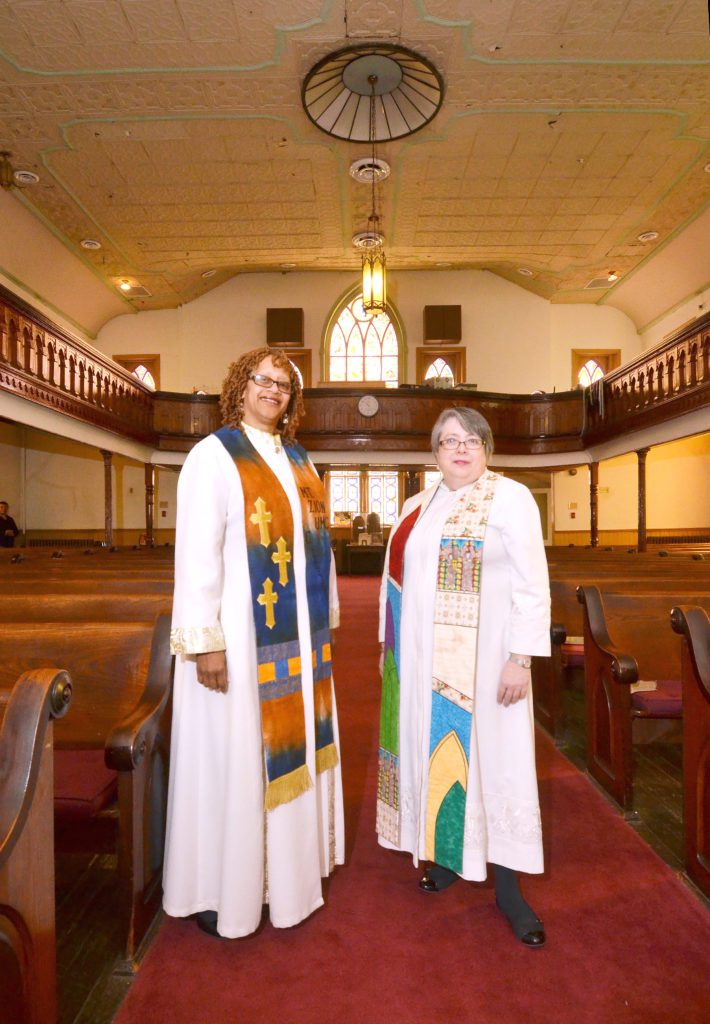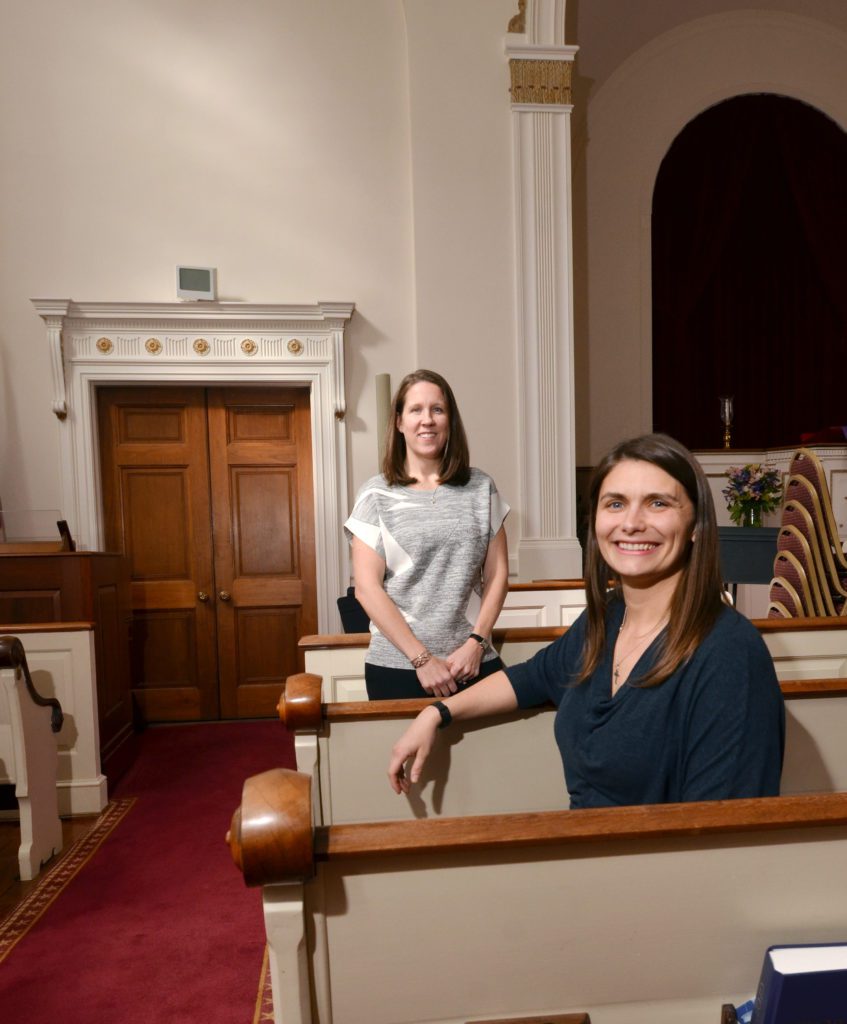Women of Worship: Georgetown’s Faithful Led Increasingly by Women
By • March 21, 2018 One Comment 3100

By Robert Devaney, Stephanie Green and Selma Khenissi
During an ecumenical Good Friday service in 2010 at Holy Trinity Church, Mary Kay Totty was the only woman to preach on one of the Seven Last Words of Christ. The other celebrants were six men. She and other ministers or priests repeat this annual Lenten gathering in Georgetown, which cycles through a different church each year.
Two years ago, it was a little different.
“The next time Holy Trinity hosted the ecumenical Good Friday service was in 2016 and that year the Seven Last Words were all preached by women,” said Totty, pastor of Dumbarton United Methodist Church.
The increasing number of female clergy through some Christian churches today and the importance and majority of women in all houses of worship and religions for millennia offer many powerful stories of faith.
In the Roman Catholic Church, the story of the orders of nuns, who teach, tend to the sick and poor and do so much more — without being priests, who alone can celebrate Mass — speaks volumes and is a fundamental part of Georgetown.
Here stand Georgetown Visitation Prep, the oldest Catholic school for girls in the 13 original colonies, the Jesuit parish of Holy Trinity, Epiphany Church and Georgetown University, the oldest Catholic institution of higher learning in America. At Trinity, women fill the ranks of those assisting on all levels — except as priests.
Likewise, women have formed the backbone of the Baptist churches here, especially those organized by African Americans.
Georgetown stands proud of its vibrant faith community during an era of declining church attendance, and the high number of women in church leadership makes it even more exceptional. In time for Holy Week, we focus on the spiritual journey of a few special Georgetown women, who show how women are more in charge of churches than ever before.
MT. ZION UNITED METHODIST CHURCH
Seven years ago, by way of the U.S. Air Force, Johnsie Cogman arrived at Mt. Zion United Methodist Church on 29th Street in Georgetown. She is its first African American female pastor.
The oldest African American Methodist church in the nation’s capital celebrated its bicentennial in 2016 with special events and galas. In 1816, 120 black men and women grew weary of the racial divide at Montgomery Methodist Church (now called Dumbarton United Methodist Church) and left to build their own place.
Many church members are related and their history can be traced back generations, not just to the current building but to the original church — and to Georgetown, where most no longer live. “Yes, we have a rich history, but we are moving forward into tomorrow to serve God and this community,” said Cogman. The church hosts a morning day-care program as well as a Sunday evening mealtime for the homeless.
A moment of reckoning came in October of 2015, when Mary Kay Totty from Dumbarton Methodist arrived at Mt. Zion to apologize to the descendants of those wronged all those years ago. Totty presented a crystal dove in remembrance of the past and in hope for their future. Even before the dove’s arrival, the two churches were serving the community together.
High on Cogman’s work list is Mt. Zion Cemetery-the Female Union Band Society Cemetery near the corner of 27th and Q Streets. Groups have joined the church to help not only clean and clear but also to research the historic resting place of black ancestors.
For the last few Sundays, the joyful Cogman — having endured cancer, divorce and the death of two children — has been telling the story of Old Testament heroines through the characters of “Hidden Figures.” She and her husband Billy have two sons, Jacob and James, both of whom are studying for a master’s degree in divinity. A new ministry makes way.
DUMBARTON UNITED METHODIST CHURCH
Born in Alabama, a child of the deep South, Mary Kay Totty earned her divinity degree at Texas Christian University. Ordained in 1989, she has served churches in the Baltimore-Washington Conference of the United Methodist Church. In 2009, she was appointed pastor of Dumbarton UMC, the oldest Methodist congregation in Washington, D.C.
“I treasure the opportunity to work with this congregation, which is so committed to peace, justice and inclusion,” Totty said. “My sermon series for Lent this year pairs scripture texts with excerpts from Dr. Martin Luther King Jr.’s writings, using the metaphor of the Jericho Road for the journey of life. Ministry is my first career — unusual for my generation. For 29 years, I have worked as a pastor in various congregations. It is uncommon for women in ministry to serve in parish ministry for so long. I can’t quite imagine doing anything else.
“We have been meeting in Georgetown since 1772. We started in a cooper shop near the river, then built a church on Montgomery Street and in 1850 built the building we still occupy on Dumbarton Street. The sanctuary has beautiful stained-glass windows and amazing acoustics. The church has vibrant and vital ministries for people of all ages. We are intergenerational and love to sing. We are committed to progressive theology and social justice. We recently celebrated our 31st anniversary of being a ‘Reconciling Congregation,’ when we publicly declared our commit to welcome LGBTQIA people into the life and ministries of our congregation. We continue to educate ourselves about racism and work on dismantling it.”

Camille Cook Murray and Rachel Landers Vaagenes. Photo by Patrick G. Ryan.
GEORGETOWN PRESBYTERIAN CHURCH
Georgetown Presbyterian’s Camille Cook Murray is the church’s first female senior pastor. Ordained at the age of 28, she is one of the youngest preachers in the church’s rich history, which dates to the 1700s. She’s shepherding her 400-plus-member congregation while caring for her six-month-old baby and another young child.
Murray said that the support she’s received from the other neighborhood clergy, particularly the women, has made her experience easier, especially after a fire ravaged her Georgetown home in January (she used the episode for a recent sermon).
Although the Presbyterians have many women in lower-level pastor positions, Murray conceded that there could be improvement in the number of women heading churches, which she estimates at only about 10 to 20 percent nationally.
Murray was looking into a premed track at Vanderbilt University, but loved her theology classes, too, which ultimately led her to seminary at Princeton.
Her associate pastor for education, Rachel Landers Vaagenes, was a math major at the University of Southern California. She formed a comedy improv group with fellow students before also heading east to Princeton.
“My sermons are hilarious,” Vaagenes was quick to point out, saying on a more earnest note: “I see myself as a translator of the gospel, good news.”

Elizabeth Gardner and Elizabeth Keeler. Photo by Patrick G. Ryan.
CHRIST CHURCH, GEORGETOWN
Not long ago a slightly disgruntled parishioner inquired why a service at Christ Church Georgetown was led by all women, including the preacher, crucifer and lector. Elizabeth Keeler, assistant rector, offered some historical perspective with her reply: “Well, for 2,000 years, there were all men.”
The Episcopal Church began ordaining women in 1974. Keeler and her fellow assistant rector, Elizabeth Gardner, tend to Georgetown’s flock of believers, preside at our weddings and bury our dead. Between them, Keeler and Gardner have two husbands and five teenagers. Gardner brings her other child, her dog Maggie, to the office.
Women at the altar would have been unthinkable when Christ Church was founded 200 years ago by a small group of white men, including Francis Scott Key, or even when Gardner and Keeler were children.
“When I was a little girl, I never saw any women in the pulpit. I didn’t question it, but I never thought of it as a career,” Gardner said.
In fact, Gardner didn’t enter the ministry until she was 45, by which time she was married, raising kids and well into her first career. “I worked in politics, and the pastor at my church told me I was trying to change the world, but not doing it in the right way. He told me I should consider ordained ministry.”
And has she changed the world yet? “There’s a lot more work to do. But I think it’s more rewarding than politics,” she said of the ministry.

Gini Gerbasi. Photo by Robert Devaney.
ST. JOHN’S EPISCOPAL CHURCH, GEORGETOWN
Gini Gerbasi, rector at St. John’s Episcopal Church in Georgetown, has been ordained in the Episcopal Church for 11 years, going on 12. She is the mother of two boys, one in high school and one in college.
According to Gerbasi, being a female rector is no different from being a male rector, for the most part. The exception is the need to find clergy blouses for women, which remains a challenge. Gerbasi’s duties include worship and program planning, visiting people who are homebound or in the hospital, running the business side of the church and meeting with colleagues to share experiences.
She acknowledges that she is in a leadership position, which includes being a member of the board of St. John’s Episcopal Preschool and meeting with community leaders. In addition, her role as a mother is never forgotten: “I’m a priest in many ways like a mother,” she said. When Gerbasi first was seen in public with her children, she noticed that her priestly insignia got a lot of strange looks — and it still does today.
Gerbasi is well aware that there are people who consider themselves spiritual but not religious; that’s one reason she does a weekly podcast called “The Irreverends.” She believes that many people turn away from Christianity because of the stereotypes that are out there in public culture. “That breaks my heart and we have to do better,” she said. Her vision of church is a balance of two things: remembering Christianity’s stories and values and adapting to the 21st century. “Women in leadership plays a role,” she added.

Brett Davis. Photo by Robert Devaney.
GEORGETOWN LUTHERAN CHURCH
Brett Davis, who started six months ago as pastor at Georgetown Lutheran, felt a call to be ordained. This call was so strong that it ended a love relationship she was in; her then-fiancé wasn’t supportive of her pursuing this path.
Before moving to Washington, D.C., with her husband, she was serving a large congregation in Harrisonburg, Virginia.
Her responsibilities differ from day to day, often including listening to and supporting people who seek her out. She also tries to reach out to people in creative ways, giving out free flowers or sitting at Saxbys, where she invites people into conversation. However, Davis said that she’s not the only person making an effort to keep the church open so that it can be a place for community. She works with leaders in the congregation — church members who volunteer and serve, including a volunteer treasurer. “I’m not a one-man show,” she said.
Though Davis noted that 50 percent or more of women in Lutheran seminaries are studying to be pastors, she said that the Lutheran community has room for improvement: “We’ve still got a long way to go on diversity and leadership.” Davis feels that more needs to be done to lift up voices of people who have different life experiences and different ethnic backgrounds. “God is always about lifting people up,” she said.


looking to Fellowship with other women leaders